There are several versions of the user guide on the management of Problem Networs in the Khomenko'sarchive . We use for the publication the latter material, dating back to 2008. Later, a series of articles on this approach were published by N.Khomenko in collaboration with European colleagues. The annex contains a block diagram of Problem Network development.Alla Nesterenko
Executive summary on OTSM Network of Problems
When we are going to perform complex journey usually prefer have a good map of the place. If we are research new territories, the map does not exist. In this case, we develop our own map as soon as we move through unknown territories.
Analysis of complex non-typical interdisciplinary problems situations could be viewed as a journey to unknown territories. Therefore it s also good idea to develop map of thinking process we pass through already. This mal will guide us through complex problem situation and help to collect set of partial solutions we could use in order to develop satisfactory solution. OTSM Network of Problem (NofP) technique was developed as a part of OTSM problem solving process but could be complimentary to many other thinking techniques and method to increase thinking process productivity and efficiency of knowledge workers. Same as tools and machines help to increase productivity of manual workers. We consider as a knowledge worker all those who use their brain to operate knowledge in order to produce new one or make decision based on analysis of certain situation.
According Peter Drucker Productivity of manual workers increased 50 times in XX century but productivity of knowledge workers remain on the same level. Classical TRIZ and OTSM provide us with a powerful theoretical background to develop instruments for knowledge worker to help them to fulfill their duty better efficient. OTSM Network of Problem is one of those TRIZ and OTSM based instruments.
OTSM Network of Problems could be useful not only to solve problems one by one. This instrument could be useful for strategic and tactics planning of the organization, product or research evolution. The point is that in the course of the Network of Problems development we collect, formalize and organize knowledge and information about problem situation the way to make it easy analysis of problem situation and solution synthesis. As a result, we obtain kind of map of general knowledge and peculiarities of the specific situation relevant to the problem situation. OTSM Network of Problems give user a big picture (map and general understanding) of the particular situation could be used many times for further needs. It could be developed further and integrated with other knowledge relevant to the business of an organization, group or individual. In this case Knowledge Management system of an organization could be better organized and presented not as a data base of reports and people of an organization but as a semantic network that represent knowledge relevant to the company needs and could be easy observed and used for problem solving and decision making in future. In addition, it is appearing for complex interdisciplinary problem situation but it could be used either for relatively simple problems. Those networks could be integrated in to general network of problems relevant to the scope of the Company activities.
OTSM network of Problems is a semantic network for representation of problems and partial solution of certain problem situation. It is a semantic map of relationships between problems and partial solutions or decisions were implemented in the past that produce now problems for the Company, group or individual because of situation was changed and new obstacles appear.
Analyses of the OTSM Networks of problems that were developed in the past could be useful either for forecasting and managing future according needs of the organization, group or individual.
Network of Problems is a part of OTSM New Problem Technology usually used to pose the problem to be solved in certain specific condition: competitive analysis of patent or situation on the market, improvement of existing products and services or developing new one, Improvement of business process of an organization or developing new business model of the company etc… For all application of OTSM New Problem Technology soon or late we arrive to the needs to observe a Big Picture of problems and potential solutions relevant to a specific problem situation. In order to obtain the Big Picture Network of Problems technique could be applied.
As a first step of NofP development, we make a list of most painful problems and potential solutions. Then we establish relationships between those problems and solutions. Then we analyze actual situation according Classical TRIZ System Operator and list of problems relevant to certain component of the system and stages of the process the system should perform but did not satisfied yet certain demand or needs of new situation around. These new lists of problems also present as a network and integrate with initial one about most painful problem, which has indicated that we have a problem situation to be analyzed and solved. To develop this preliminary Network of Problem we use
During next stage, we analyze initial descriptions of problems and potential solutions and decompose those of them, which is necessary according special rules. As a result, appear map of problem situation that describe the problem situation by better-formalized way. In addition, if the map was develop by the group it is helpful to obtain mutual understanding of the problem situation and pose the goals to be achieved. Often the process of NofP development helps eliminate some misunderstandings between people about perception of the problem situation or, at least pointed it out for further work to overcome these misunderstandings and make problem situation clear.
As soon as clarified and formalized map of problem appear we can start to analyze it according OTSM rules and/or implement some simple TRIZ and OTSM based instruments. OTSM rules of Problem Network analysis help to make visible bottleneck of problem situation, the most important roots of the problem situation that should be eliminated or bypassed in the course of problem solving process. We have also rules that indicate some point of problem situation were we have to pay special attention in order to better understand what is happening in our system or process and was not clear enough before. Sometimes problem situation could be resolved on this stage if participant of problem solving session have all necessary competence. During process of NofP development, from time to time rules indicate us that we have not enough competence and certain experts should be invited. If problem was not resolved during this stage then we could use OTSM Network of Problems to chose set of problems to be analyzed deeper by TRIZ and OTSM based instruments or any other techniques. OTSM deliberately was developed the way that is helpful to integrate it with many others of instruments for knowledge workers.
Acknowledgement
I would like to say thank you for cooperation and opportunities to test and develop further OTSM and OTSM based instruments to my, partners, customers and students from Research Laboratory of Inventive Machine (Now IMCorp), LG-Electronics, Samsung, PSA Peugeot-Citroen, Arvin Meritor, Forecia, INSA Strasbourg, European Institute for Energy research, Institute of Innovation and Technology transfer, EADS, Salomon, Tarpey Printing House, Alstom, Bosh-Siemens, and others.
Special thanks to Dmitry Kucharavy, Victor Timochov, Youry Paplevka, Leonid Dinershtein, Pavel and Tatiana Fadeev, Tatiana Sidorchuk, Ingrida Murashkovska, Anna Korzun, Alla Nesterenko, Alexander Sokol and many my of my colleagues and friends and all participants of Jonathan Livingston Project. Their critical opinion was very helpful. Lot of thanks to Roland De Guio, whose support was valuable and important for OTSM development during period of time I spent at ENSAIS (now INSA Strasbourg).
Names of two outstanding personalities I was lucky to meet in my life Genrich Altshuller who initiate, support, anchorage and supervise my research about OTSM. And second personality is Kim Khadeev who was always ready to read and discuss my working materials, who provoke lot of inspiration and insights he also propose to introduce third postulate of Classical TRIZ that was never presented clear in the Altshuller’s writings postulate of specific situation. This postulate was totally accepted by the author of TRIZ - Genrich Altshuller and helps harmonize postulates of Classical TRIZ. Kim Khadeev also gave lot of insights about system of OTSM postulates his encyclopedically erudition and open mind help us work together long time and share difficulties of his and my research about thinking process instruments. Unfortunately, his book about dualism in the world and fairy tail he has been writing more then 25 years was not finished. These two people never meet each other but their live stories are very similar: both of them spend several years in Stalin prisons, both of them carried our research about thinking process, both of them had lot of trouble with state and scientific bureaucracy, both of them did not finish their most important writings…
Introduction
Result of problem solving procedure depends a lot on the way how initial problem was described. Members of problem solving team or project have different perceptions and understanding of the problem situation and its components. They also have different vision of what should be result of the problem solving process. OTSM Network of Problems is an instrument to obtain a ‘big picture” of a problem situation to be solved and increase the level of formalization of the initial problem situation representation in order to be solved by TRIZ and OTSM based instruments with or without computer support. The Network of problem could be helpful to clarify system of goals to be achieved at the end of problem solving process.
Work on developing Network of Problems could be also helpful to share and harmonized individual points of view of a problem solving team members.
As soon as Network of the specific problem situation is done according OTSM rules we can use it for navigation on problem situation by analyzes topology of sub-nets of problems. This analyzes help problem solvers choose the key points in the problem situation and develop strategy and tactics of the problem solving process.
In the course of problem solving process the network of problem evolve according new knowledge the team obtain and could be used in future for further improvement product, services, organization functioning and it business models as well as for developing strategy for R&D and Advanced R&D.
Finally OTSM Network of Problems as well as other components of OTSM Problem Flow Networks approach allowed to switch from randomly and occasionally organized problem solving session to better organized problem and knowledge management. Problem Management could be better efficient if the company knowledge management system could be coordinated with problem management according OTSM theoretical background and practical instruments. This is especially important for complex interdisciplinary problem situations that many companies faced with more and more often.
Historical observation of Classical TRIZ and OTSM evolution show that the more efficient OTSM and TRIZ instruments appear for complex problem solving the more we change our understanding of complexity. It seems like a skyline: the more closely you are the far away the skyline move.
Modern instruments of Classical TRIZ and OTSM (ARIZ, TRIZ System of Standard Inventive Solutions, Four main OTSM Technologies: New Problem Technology, Typical Solution Technology, Contradiction Technology and Problem Flow Networks Approach etc.) work efficiently for the problem situation that could be presented as a set of several contradictions. For instance, discover reasons of negative effect and eliminate them or improve certain engineering system or organization.
All of those instruments are dedicated to narrow area of research in order to discover the roots of a problem situation and develop a satisfactory conceptual solution. But as soon as problem situation appear as a many interdisciplinary problems which are linked and depend on each other those instruments should envelope accordingly.
Research that was done in the Insight Technologies Lab and by members of Jonathan Livingston Project in cooperation with INSA Strasbourg and European Institute for Energy Research (EIfER) dedicated to make next step in TRIZ and OTSM evolution, make them in line with new understanding of complexity and supply problem solvers and strategy planners with appropriate toolbox.
OTSM Network of Problems step by step (see also Flowchart)
An initial list of problems.
First initial list of most painful problems, things (problems-solution, challenges, direction of the evolution for specific situation of your organization and barrier you could see now and foresee in future) could be done without any specific organization. Members of the problem solving team individually or in a groups prepare lists of problems which they consider as a most important and painful problems.
However, it could be a good idea if you will present this list as a table with 3 columns:
1. Number of the things (Problems etc.)
2. Name of the things (problem etc.)
3. Short description of the things (problem etc.)
One more way to present the initial list of problems: use standard header of the MS Word as a title (name of the problem). And bellow the located short description of the problem.
Each item of the list is a short description of the problem in free form. Then problem description should be clarified with OTSM experts. Eventually participants learn the rules for initial problem representation in the list of problems.
If some solutions of the problems could be proposed but those solutions could not be accepted for certain reasons we should collect those partial solutions with relevant problems. Solution that could not be accepted should be considered as a partial solution (PS). Partial solutions could not be accepted for two general reasons: (1) Solutions solve one problem but produce another one (chain of problems); (2) solution solve just one or several sub-problems but not the problem situation completely (Sub-domain of the whole problem domain).
Example:
Description of the problem as it was done by the domain expert.
“In order to increase temperature of water in the outlet of heat pump we could increase pressure of working medium. But in this case new working substance should have critical temperature lower than outlet temperature.”
Description of the problem after clarification with OTSM experts.
To increase temperature of water in the outlet of Heat pump it is necessary to increase the boiling temperature of the working medium. It could be done by increasing pressure of a working medium but the working medium that is actually in use has temperature of decomposition lower than could be its temperature in the heat pump under higher pressure. Therefore working medium could be decomposed and lost its properties we are interested in.
As a result we must replace working medium to make heat pump able to work under high pressure. Unfortunately there is not working medium that fit all requirements and regulations.
Here Proposals to increase pressure of Working medium and replacing working medium are Partial solutions. Increasing pressure in the cycle of working medium leads to decomposition of the working substance. Replacing working medium theoretically could solve problem but appropriate existing working medium do not fit some other criteria.
* * *
System Operator Analysis of the problem situation[1].
As soon as we collect list of most painful problems we can see that each of those problems appear on the certain level of system hierarchy (Hierarchy Dimension) and on a certain stage of the process (Time Dimension).
Next stage of developing list of problems to be presented as OTSM Network of Problems is creating Hierarchical schema of the existing or hypothetical system (in case the system is under developing) and it technological process (Time Dimension of Classical TRIZ System Operator).
Now we can use Hierarchy and Time dimension in order to reveal additional problems that should be taken into account in the course of the problem solving process. For this we analyze each step of technological process the system is design to fulfill for. Each of these problems is relevant to a certain level of the system hierarchy. Therefore we should analyze also all levels of hierarchy and problems that each level generate or indicate.
For all additional problems should be collected their partial solutions.
Any other tricks and methods could be used also in order to collect initial list of problems for the given problem situation.
As soon as new problems do not appear from Domain Experts we can focus on the initial problem network development in a form of semantic network to visualize problem situation description and make analysis of the problem easier. It is necessary to mention that if Network of problem has several hundreds of sub-problems and partial solutions visualization effect degrades. In this case could be better to use special software for Graphs or Semantic network analysis (for Instance GrIn, PFN-Assistant, Protégé, etc.) and apply OTSM rules for this kind of computer based analysis.
Developing initial version of the Problem Network
The goal of this stage is to establish relationship between problems and partial solutions in the form of a semantic network (Oriented named graph.). See picture 1 bellow.
To develop Network of Problems various graphical editors could be used. Usually we prefer Microsoft Visio or looks like.
If Arrow link problems and partial solutions together and indicate which sub-problems should be solved or partial solutions should be implemented in order to solve given super-problem.
According the rule Arrow should go out of the node box from the bottom side and come into node box from the top side of the box. See Pict.1.
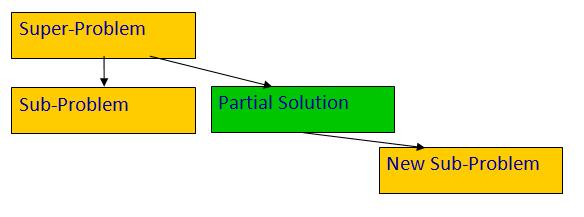
Picture 1. Arrow direction: from top to down. From super-node to a sub-node
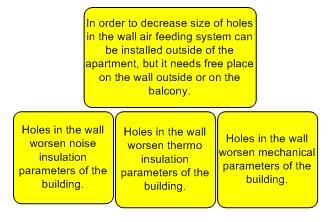 If relationships between problems and partial solutions unclear yet bet it seems they have certain relationships to each other, those problems and partial solutions are grouping together on the diagram for further clarification of their relationships. See Picture 2.
If relationships between problems and partial solutions unclear yet bet it seems they have certain relationships to each other, those problems and partial solutions are grouping together on the diagram for further clarification of their relationships. See Picture 2.
Picture 2. Sub-set of nodes for further clarification their relationships to each other
Eventually between all problems and partial solutions appear arrows that show their relationships to each other. Initial network of problem is ready to be analyzed and improved.
Goal Analysis
On this stage of the Network of Problems development we should pay attention for the nodes of the graph that do not have any arrows that come into the node box. These nodes we should consider as a Goals to be achieved. It is necessary organize them into system of goals by establishing relationships between goal nodes.
According OTSM rules these nodes should be located in the top of the Network of Problem Diagram.
While organizing Goal Nodes we simultaneously reveal the set of criteria of good solutions. Good solutions are solutions that help us to solve the top goal problems.
Decomposition of problem and solution descriptions
When we have general criteria for evolution of obtained solutions we can decompose some problems and solutions. Sometimes problem description contains description of partial solutions as well. Other problem descriptions show up that they are sub problems that appear as a result of implementation of certain partial solutions. Some partial solutions could be decomposed into several partial solutions or sub-network of problem and partial solutions. See Picture 3 for examples.
All of these sub-graphs should be properly integrated into initial Network of Problems.
After certain practice decomposition of problem and solution nodes could be done on earlier stages of initial Network of problem development and even during gathering problems for the lists of initial problems. But at the beginning it is better focus on decomposition after Goal Nodes are organized into system.
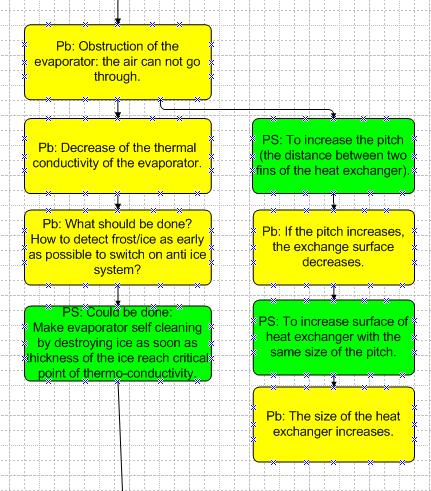
Picture 3. Examples from Heat Pump Problem Decomposition (need additional discussion) Visio Diagram
It is important to notice that sometimes decomposition of problem and solution description could lead to special sub-net of problem large enough. According OTSM model of non typical problem solving process should be presented as a fractal structure. That is why some problems or solutions could be deployed into sub-network of problems and each network of problems should be considered as a part of Super-network of problems. For instance network of problems relevant to certain project of a company is a sub-network of the whole company Network of Problems. At the same time some sub-problem of the project could be presented as a large network of problems. Imagine you work on the network of problems that develop and produce software. Your company would like to produce new kind of sport shoes for mount ski (initial network of problems). This kind of shoes should be easy and reliable disconnect in case of accident (sub-network of problems). Company needs new model of shoes because of competition on global market (part of the whole company network of problems) and to survive company need to develop new products, new business models and be able operate under big stress of permanent innovation. All of these are sub-problems of the Company network of problems.
Short Cut edge (arrow) analysis.
Sometimes on the Network of Problem Diagram we can find shortcut edge (arrow). See Picture 4. In this case we have to pa additional attention in order to clarify why this shortcut appear. Usually it shows that some sub problems are missed or we can eliminate this shortcut. Sometimes we can extract additional information about initial problem situation and rearrange whole diagram accordingly.
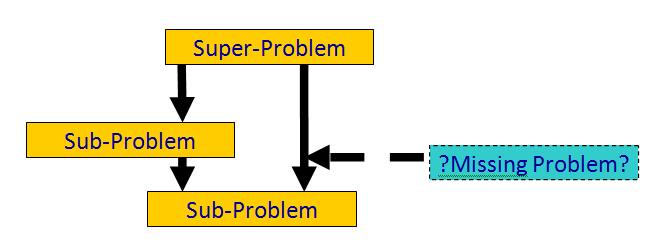
Picture 4. Shortcut edge
Circle Analysis
Special attention we should pay also for the circle sub-graphs. See picture 5. Often they indicate some important hidden contradictions or closed circle situations in problem situation. Often additional information should be gathered and/or new sub-problems and solutions could be disclosed. At the beginning it is better do the circle analysis in cooperation with OTSM expert.
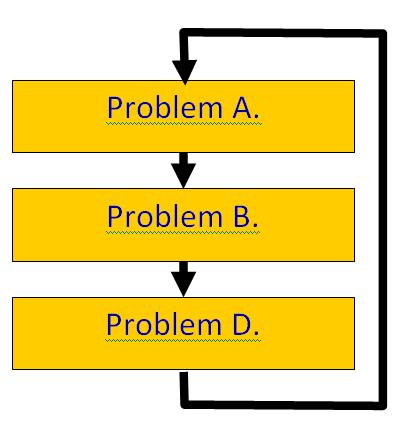
Picture 5. Closed circle
* * *
After each analysis above list of problems should be properly corrected and saved for further needs.
As soon as all analysis above are done and all changes in the list of problems were performed we could consider that developing of the network is finished and it is necessary switch to analysis of the obtained problem situation description.
Analysis of the bottle neck problems.
In the OTSM Network of Problems bottle neck problem or solution appear as a node of network that has two and more inputs from different problems or solutions. See picture 6.

Pcture 6. Diagram of bottle neck problems
Bottle neck problems or solutions often indicate that at least one hidden contradiction could be found here. Often it is a system of contradictions.
A bottle neck problem indicates that at least solution of several problems depends on this bottleneck problem. So it is meaningful focus on these kinds of problems first. The more super-nodes depend on the bottleneck node the more important the bottleneck.
The Rule 1: Out of several bottleneck nodes we should choose the node that has maximum incoming arrows (edges).
The Rule 2: Before Analysis check if there are some a short cut arrows (edges) to this bottleneck node. If you found some, then perform short cut edge analysis (see: Short Cut edge (arrow) analysis.).
A network of problems could have several bottlenecks with lot of inputs. In this case better choose those nodes which are closer to the Goal node (node without incoming arrows) i.e. the node that represents Ultimate Goal of the problem solving project.
The thing is that each solution will change something in our system or environment of the system. As a result Network of problems could be corrected the way that problems bellow Bottle neck in the hierarchy of problems could disappear with all its sub-problems.
The Rule 3: Out of several bottleneck nodes chooses the one that has shorter link (edge) chain to the Goal node (Ultimate Goal) – the node that does not have Incoming edges (arrows).
Based on this analysis we can choose one or several bottleneck nodes we have to pay attention first of all.
As soon as bottle neck and other analysis are performed it is a time to choose set of problems (bottleneck, closed circle etc.) to formulate set of contradictions to be transformed into network of contradictions.
Appendix to work further.
Solving process for problems described by several contradictions appears as a routine work for professional TRIZ and OTSM experts. However, TRIZ and OTSM professionals are more and more often faced with problem situations requiring the analysis of tens or even hundreds contradictions.. Instruments of TRIZ and OTSM should be developed further in order to help human handle this kind of problem situations. That is why in frame of OTSM is proposed the so called Problem Flow Networks approach (PFN)- an instrument that integrates all others TRIZ and OTSM instruments in order to work efficiently with complex (tens and hundreds problem situations) interdisciplinary problems like the improvement of a Power Plant or the development of concept for a city evolution or the development of Sustainable Energy Region etc.
Motivations
We shall now give some practical motivations for computer support to PFN approach. PFN approach aims at obtaining a better understanding and a picture of a problem situation and reducing research area about problem situation in order to develop satisfactory conceptual solution.. When problem situation can be described as a set of several more ore less independent contradictions that can be eliminated one by one, obtained partial conceptual solutions can be relatively easily converged into satisfactory solution, prototyped and implemented. But when working on Power Plant improvement for instance, the previous strategy for getting a solution poses some problems. Indeed, during implementation, new problem that were not planned arise and have to be handled. As a result Problem Solving process appears as a permanent management of problem situation analysis, solution development and implementation. In order to manage this kind of situation, it is not enough to solve problems, but it is also necessary to forecast new ones, which should appear as consequences of obtained and implemented solutions. Anyway, a big picture of those problem situations should be maintained permanently and regularly. As a matter of fact OTSM instruments can be helpful, but it seems that human who use them reach limits of his mental ability and skills. Human needs computer support to present knowledge about complex interdisciplinary problem situation that contain several hundreds and even thousands of problems and contradictions. Moreover, the knowledge about problem situation should be transferable between individuals and generations.
PFN approach is based on four kinds of networks: Problem Network; Contradiction Network, Parameter Network (Specific) and Parameter Network (general)[reference]. In this paper, we present a method to develop and analyze the Network of Problem in order to transfer it into a network of contradictions which are to be solved in order to obtain a system of satisfactory solutions. This method was implemented for the improvement of power plant. As a result, in March 2006 a patent was obtained.
Analyzing the Network of Problems at the initial stage
Network of Problems could be considered as a part of Human-Computer Interface. In the course of cooperation between computer and human appears a directed labeled graph - semantic network. Nodes present problems and partial solutions, edges relationships between problems and solutions. This network allows both gathering and analyzing global knowledge about initial situation. It is developed according rules and therefore can be analyzed according to formal rules in order to discover bottleneck of the problem situation and some other important details that should be analyzed further by human or in cooperation with computer. For instance, some problems should be decomposed into sub- network of problems.
Let’s give here some simple rules of analysis of the network that will be developed in the final paper:
- Cycles of the Network of Problems are usually indicator of hidden contradictions.
- Chains of successive nodes like Problem-Partial Solution-New Problem show the contradiction to be solved (in classical TRIZ this situation is named Technical Contradiction).
- Nevertheless, as soon as network of problems contain a lot of those obvious contradictions another rule have to be applied in order to narrow research area to develop satisfactory solutions: we have to focus first on “bottlenecks”. Bottlenecks are nodes that have a lot of inputs in the completed network of problems.
The problems we faced with are about quantity of nodes in the network of Problem. As soon as amount of problems less then one hundred, it is visible and easy to discover bottlenecks and cycles. However, visual analysis of the graph becomes difficult when the number of nodes increases and reaches a hundred. Classical algorithms out of graph theory can be used to detect cycles, bottlenecks, and specific chains and sub-graphs.
At the present stage of software development this kind of tools is available, but additional features are required in order to handle the practical process. It is important that this software provides user with some other important features like database of problems and a system for keeping steps of evolution of the network as well a simplify report preparation. Indeed, as we mentioned above the most complex problems should be managed and could not be solved at once and forever, therefore in Frame of OTSM we use the term Problem Management instead of Problem Solving.
Moreover in order to develop our research further an additional feature is required: software has to be organized such a way that additional rules (for analysis or evaluation) can be easily added and combined by the researcher. This is the purpose of a current project at LGECO that focuses on graph analysis and representations with a meta-language [reference].
Using the Network of Problem at further stages
In previous part of the paper we focused on the system of rules we have today to develop and analyze the semantic network that describes initial problem situation. However, the OTSM Network of Problems can also be used to analyze and evaluate solutions more objectively in the context of the whole problem situation that was discovered while developing the Network of Problems. For instance, when obtaining a solution that looks feasible and satisfactory, the Problem Network can be used in order to assess which problem could be solved by the solution and which problems still remain or even get worse.
OTSM based Problem Network could be implemented for Knowledge Management system of an organization to represent, gather and keep up to date information about certain problem situations relevant to the business of company. These networks could be useful to support project management process, as well as decision-making process and strategy and tactics planning. This support could involve computer support and advice system.
Network of Problems could be considered as a tool for Knowledge management because it presents in a formal and compact way the knowledge relevant to the problem situation that could be easy analyzed by human. It may prevent from reading a lot of reports about problems and its evolution within organization and outside it to get the same level of understanding. Cooperation with people of knowledge management during the solving process would allow memorizing knowledge about the problem situation and it solutions in an appropriate shape for the company. If appropriate software could appear then it could be useful not only for temporary team that works on the problem situation but for other groups and especially for decision makers and knowledge managers. We also consider that OTSM based software to support OTSM Problem Flow Networks Approach could be system integrator for various problem solving support and knowledge management software.
Conclusion
The following points will be presented in the paper with more details:
(1)` Why is software needed to support Problem Network development process?
(2) How could the Network be developed and analyzed (with some real case example);
(3) How can the Network of problem be helpful to perform rest of problem solving process?
(4) Why could the result of the coaching sessions performed with the support of the software be useful for further projects?
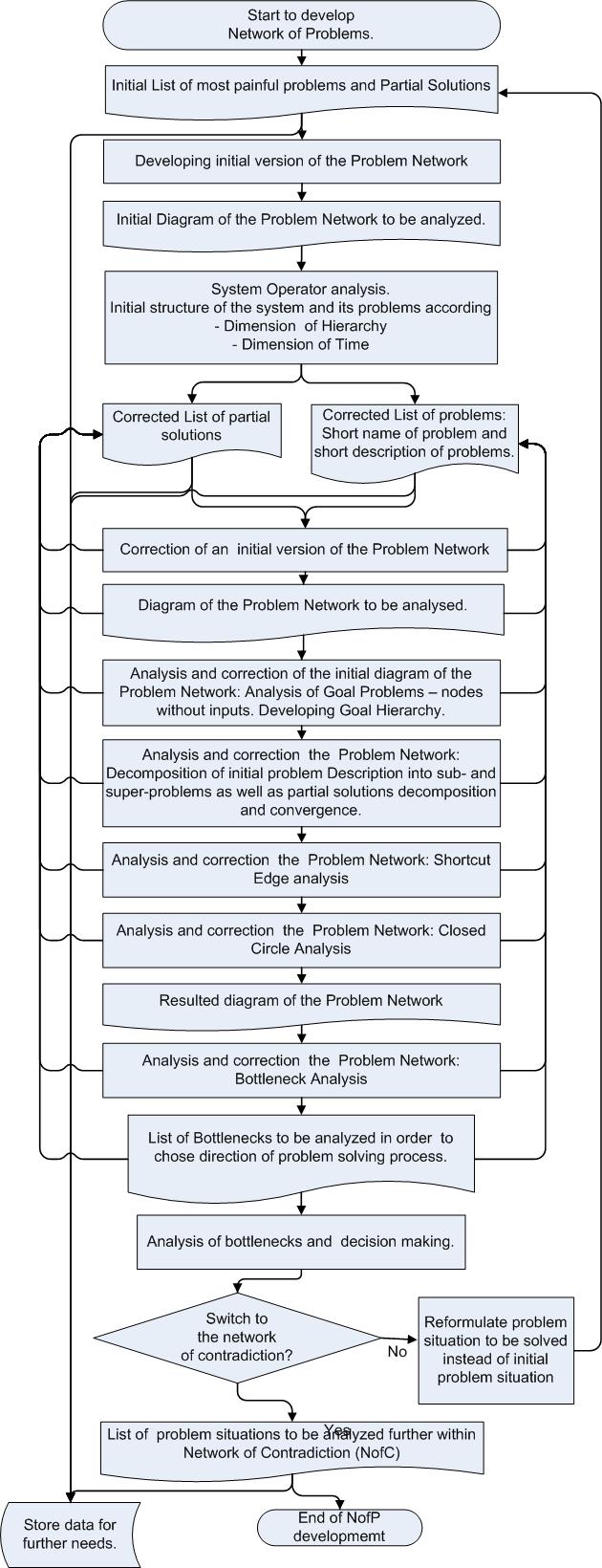 Annex 1
Annex 1
- 33536 reads
- Русский


Recent comments
12 years 39 weeks ago
13 years 39 weeks ago
13 years 39 weeks ago
13 years 39 weeks ago